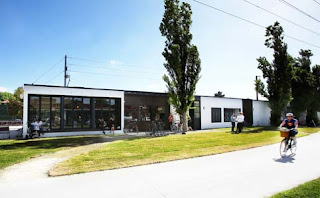I was out of the city about a week ago and duly pulled in at such a bakery for coffee and treats. After choosing what was by name a pastry, but was in practice a giant custard repository, I happened to spot an old vintage drip/filter coffee machine perched on one of the benches.
“Does the coffee come from that machine?”, I asked the woman behind the counter.
“No”, came the reply, “that’s just there for show. We do the fancy, good coffees now.”
She was, of course, referring to the bakery’s espresso machine. So I ordered a “fancy” coffee.
And, as expected, it wasn’t very good. In fact, it was terrible.
Now, we all know that Melbourne has a serious coffee fixation. We take it as a given that everyone in Melbourne knows that Melbourne is known Melbourne-wide as having the greatest coffee in the world. We see for ourselves how the local rag uses more column space to fawn over baristas than it does to cover the ongoing conflict in Syria. We bemuse visiting backpackers who arrive with dreams of sun and sand and instead find black-scarf-and-coat-clad grumpletons sipping macchiatos out of little cups in the drizzling rain.
Yes, Melbourne has embraced coffee—espresso-based coffee in particular—and as a result there are some outstandingly excellent places to get a cup of this magic drink around town.
But herein lies the problem; the very problem I came across at that country bakehouse.
Because of the success of a few establishments, EVERYONE serving coffee now feels obliged to get on the espresso coffee bandwagon—and the results aren't good.
For me, the last straw was seeing espresso machines in petrol stations, installed there in ignorance of the cold fact that an espresso machine is not a magic bullet. It actually takes a fair amount of specialised skill and training to make a good-to-very-good cup of espresso-based coffee. And conversely, it is very easy to bugger things up.
We’ve all seen and tasted the screw-ups: milk so over-steamed it burns both itself and the drinker; last year’s stale beans being fed through the machine; milk not-so-surreptitiously re-poured and re-steamed from jug to jug; a milk-to-coffee ratio of 158:1; cheap and nasty office or café self-service pseudo-espresso machines that produce weak and watery cups of slop.
So what is (or what was, in times gone by) the alternative? Simple. A pot of no-nonsense, black, drip/filter coffee, with a jug of milk and some sugar alongside if needed. Will it blow your mind? Probably not. But is it good, dependable, honest, and much harder to bugger up? Yes.
Essentially (in my opinion) it is easier to make an average pot of coffee than it is to make an average espresso coffee, and an average pot of coffee will usually be better than an average espresso coffee.
Therefore, places that cannot do espresso properly should not feel pressured or obliged to do it at all.
Therefore, places that cannot do espresso properly should not feel pressured or obliged to do it at all.
A venue that switches to espresso coffee simply because "everybody else is doing it" is like the grandparent or older relative who previously sent you lovely hand-written letters—and now sends you emails because that's the "thing" to do. The former is carefully crafted, warm, and personal. The latter is (usually) an unmitigated disaster of capital letters, misdirected emails, formatting nightmares, and whole messages written entirely in the subject line.
The last pot of old-school coffee that I've seen was at the Beechworth Bakery in Healesville around 2009. Does this still exist? Do you know of any other venues? Please share if so!
Returning to the problem of countering the side-effects of the espresso revolution, we are left with essentially two solutions:
- Encourage underperforming establishments to revert to old-fashioned pots of coffee; or
- Give underperforming establishments the kick up the ass they so desperately need.
In late 2012, local coffee behemoth St Ali opened a new venture. As the crow flies, it is located in a north-north-easterly direction from the original St Ali, but (for the sake of brevity and reduced sign-printing fees) it has been simply titled St Ali North.
But I feel like St Ali has missed the boat on this one. Sure, the café will rake in oodles of cash—it is next to a bike shop, a bike path, a park, a tram stop, and is smack bang in the middle of four suburbs that are singlehandedly keeping the unnecessarily large spectacle frame industry in business.
Still—where’s the challenge in setting up shop in a place like that? Where’s the bold, adventurous spirit?
You see, if the powers behind St Ali really wanted to shake things up, here is what should have been opened: St Ali Far North.
The Hume Highway stretches inland out of Melbourne’s northernmost reaches. It contains several examples of the greatest evil ever visited upon the road traveller—the highway service centre. Housed in dingy 1970s-era buildings, these roadside stops are the elephant graveyard of human hopes and dreams. They serve awful food. And terrible espresso coffee.
Think of the roaring trade and cultural impact a Melbourne-style café like St Ali Far North might have on the Hume Highway! Knobbish city-types with blogs can get their proper coffee fix while driving to country bakeries! Truck drivers will acquire tastes in single-origin coffees that will force other coffee-dispensing service centres to shape up or ship out! Fixed-gear bicycle accidents on the Hume Highway will triple!
What’s not to like? The rent is cheap, a great challenge beckons, and the rewards will be great. Sure, there might be problems convincing staff to relocate from Brunswick to Hume Service Road B, but if the mining companies of Australia can fly in their workers via helicopter, then I say: so can our cafés.
Bring it on.
Bring it on.





No comments:
Post a Comment